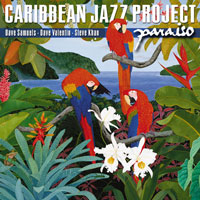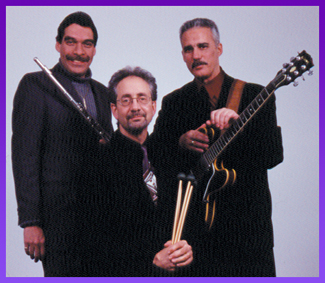

|
Soundclip:
|
|
See Steve's Hand-Written Lead sheet |
|
Steve Khan's "El Tacaño" Lead Sheet |
|
I first became aware of the name Clare Fischer when he appeared on the Jazz Crusaders' classic "Latin jazz" recording, "CHILI CON SOUL"(Pacific Jazz) which was recorded sometime during 1965. On this same LP(to this day, I've never seen it released in CD format, not even in Japan), I also heard his music for the first time and it left a lasting impression. His tunes, "Dulzura" and "Ontem a Noite"(which I later recorded on the "HEADLINE" CD) have remained favorites of mine for years. His knowledge of and feel for the Latin idiom is unequaled and he is seen as a giant in the music. His beautiful harmonic approach, his usage of subtle inner voice movement are things which seem so very unique to him. I suppose this piece, "El Tacaño," was most influenced by Clare's tune, "Novios" which appeared on a Cal Tjader CD titled, "HURACÁN"(LaserLight). "El Tacaño" appears on the new Caribbean Jazz Project CD for Concord Picante titled, "PARAÍSO" which will be released in April of 2001.  For this track, in addition to full-time bandmates, bassist Rubén Rodríguez(who, to me, is like the Ron Carter of contemporary Salsa and Latin music) and conguero Richie Flores, we were joined by the great Luisito Quintero on timbales. For this track, in addition to full-time bandmates, bassist Rubén Rodríguez(who, to me, is like the Ron Carter of contemporary Salsa and Latin music) and conguero Richie Flores, we were joined by the great Luisito Quintero on timbales.
The fundamental germ, the 'guajira' of "El Tacaño," appears in letter [I] and is something I had been fooling around with for quite some time now. I actually thought we might use it as a 'vamp' when Dave Samuels introduces the group during a concert, but that never quite materialized. In my particular style of writing, I seem to like to begin with something which conveys a "mood" and has an "attitude" about it. Once an idea like that comes to me, the rest may take awhile, but I at least know that I am onto something of substance. Something which feels 'right' to me. Though it was always obvious that it would be played over a Bb pedal(really a bass tumbao composed of roots and 5ths), the movement from an Ab/Bb to C/Bb, then to a Bb triad, and finally back to the C/Bb chord is a bit strange. Strange, but beautiful, and interesting to me, and, it presents interesting challenges in composing a melody. What I have now come to like about the melodies is that they seem to exist almost apart from the guajira which, to me, is very much in the style of Clare Fischer's writing. Though he does it far, far better. For this particular piece, it felt right to divide the melodies, [A] and [A2] up by returning to the guajira for 8-bars, [I2], in between, and using a new melodic fragment. In this way, [I3] functions as a bit of a surprise when, after just 6 bars, it serves to move us via a transition into [B]. [B] features a bit of a 'bluesy' release from the guajira and a much more angular melody. The little melodic configuration in bar 4 actually reminds me of something saxophonist Steve Grossman improvised on Miles Davis' "JACK JOHNSON" recording years ago. The chordal transition which begins at the end of bar 5 takes us into a second guajira which lies a half-step above what we heard in [I]. Normally, as a guitarist, I would have written these melodic and harmonic elements one octave above where you now see them. They appear here in 'concert' register so that vibraphonist Dave Samuels doesn't have to squint to read all the leger lines above the staff. It's purely done as a courtesy for a respected colleague. Again, the goal in writing music for your bandmates is to have it communicate quickly so that valuable rehearsal time is not wasted. You want to learn as quickly as is possible just what works about what you've written and, what does not! Initially, when [C] was composed, I thought that it would sound great if the bass line marked the movement of the full chords: B7 to Cb/Db to D7(9) and then back to Cb/Db. The first time we rehearsed this, it sounded SO awful that I got depressed and wanted to throw out the entire tune! I often have this feeling when listening for the first time to something I've written! But, I just took it home and began to tinker with this section until I arrived at what you see/hear now. I changed two things: [1] I simplified the bass tumbao to a 'B'-pedal(again simple roots and 5ths), and; [2] changed the color of the last chord to a B7(sus) voicing. This gave the harmony some 'character' while retaining the inner voice movement. The melody in this section also conveys a strangely 'bluesy' attitude as well with the inclusion of several 'D'-naturals and 'F'-naturals. To me, it also has a mildly comedic sense to it, almost as if one could visualize "El Tacaño" walking down the street with his hands covering his pockets so that nothing(no money) can fall out! Perhaps this might be a great time for a little break from the musical portion of this 'analysis?' So, just what does "El Tacaño" mean, for those of you who speak less Spanish than me?  Well, simply put, a "tacaño" is a: "tightwad," a "skinflint," or "cheapskate." In truth, I just loved the sound of the word. It really has NO direct relation to ANYONE! And certainly NOT to Clare Fischer! The reason the tune was dedicated to Clare was for his influence on the music and nothing more! Well, simply put, a "tacaño" is a: "tightwad," a "skinflint," or "cheapskate." In truth, I just loved the sound of the word. It really has NO direct relation to ANYONE! And certainly NOT to Clare Fischer! The reason the tune was dedicated to Clare was for his influence on the music and nothing more!
The solos, [D], are taken over a particular Bb blues chord sequence which really comes from Wes Montgomery's solo changes to "Freddie the Freeloader"[from "PORTRAIT OF WES"(Riverside)]. The touch he adds, which I like so much, is that as the progression descends from the V7(F7) to the IV7(Eb7), it continues downwards by sitting on a nice III7(D7) chord for two bars instead of the expected return to the I7(Bb7), or a more traditional turnaround of some sort. I've actually used this progression before in another tune of mine, "The Blue Shadow" which appears on the "MODERN TIMES/BLADES" recording with Anthony Jackson, Steve Jordan, and Manolo Badrena. In [D2] which is cued by the soloist, the chord movement from letter [B] is used as a release. Initially, I had this little release section with 12-bars, but it never felt right to any of us, so it was cut down to 8-bars. Again, one must be flexible and follow their best musical instincts, but also to listen to their bandmates! The little 4-bar transition figure, which is also used as our 'introduction,' owes a bit to a particular harmonic movement Chick Corea was employing a lot during his recordings from the mid to late '60s. After the last solo, the restatement of the [A] and [A2] melodies is broken-up by a percussion solo [E] which is taken over the fundamental guajira. Initially I wanted the brilliant Richie Flores to solo over this section but Richie was exceptionally generous and asked if Luisito could have the solo and so I was happy to do that as well. [E2] was added to give the percussion solo a 'lift' to its conclusion. We had many discussions about this, and its effectiveness. And, there was some disagreement between all of us, but in this case, I decided to go with my own gut feeling and to keep the melody as it had been written. In [A2], the final melodic statement, we play the little triplet figure, which has appeared in bar 8 of each [A] section, as an ensemble. It is the ONLY time we do this, fighting the instincts of some, during the entire piece. I had always felt that this would be the most effective thing to do, and to resist catching the figure any sooner. The [Tag] puts to use our Intro and solo transition figure again. But this time, it's really but a paraphrase of a portion of it. Notice the beautiful percussion work of Richie and Luisito in the small space which exists between the end of beat 2 in the next-to-last bar and final hit on beat 2 of the last bar. What they played live is augmented by a counter rhythm from Luisito's overdubbed campana(an additional handheld cowbell usually played by the bongocero). Harmonically speaking, on the last hit, for example, you'll notice a voicing which cannot be fully played by the guitar. In this case, as so often happens in this group, Dave Samuels and I work together to utilize the cluster capabilities of the vibes, and we simply divide-up the harmony to create the full and more lush sonority. As this is the first addition to KHAN'S KORNER for the year 2001, I will hope that you enjoy being able to view and hear this piece of music in advance of the CD release. And, that you will be inspired to check out "PARAÍSO" by the Caribbean Jazz Project! Again, here's wishing you all a very Happy New Year! ¡Felíz Año Nuevo!
[Photo: Dave Valentín, Dave Samuels, and Steve
Photo by: Richard Laird] |
| KORNER 2 | HOME |